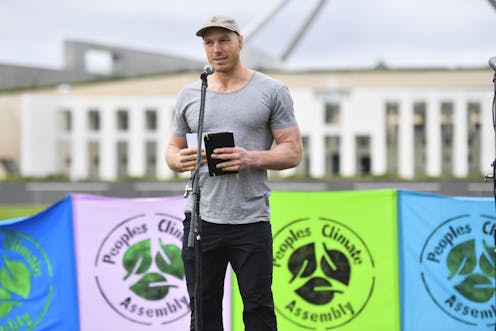Pocock defeats Liberals in first time Liberals have not won one ACT Senate seat
- Written by Adrian Beaumont, Election Analyst (Psephologist)

The federal election result for the ACT Senate[1] was decided Tuesday. Independent David Pocock defeated the Liberals’ Zed Seselja, with Labor holding the other seat. Pocock is a former rugby player[2] who played for the Australian Wallabies and ACT Brumbies, and a climate activist.
This is the first time since the NT and ACT started electing two senators each at federal elections since 1975[3] that Labor and the Coalition have not had a 1-1 split in both territories.
With two senators to be elected in both territories, a quota is one-third of the vote, or 33.3%. Final primary votes[4] in the ACT were Labor 1.00 quotas, Liberals 0.74, Pocock 0.64, Greens 0.31, independent Kim Rubenstein 0.13 and UAP 0.06.
After preferences, Pocock defeated Seselja by 1.09 quotas to 0.86 according to ABC election analyst Antony Green by winning 72.5% of all preferences to just 18.9% for Seselja.
The NT Senate result has also been finalised. Labor won 0.99 quotas on primary votes[5], the Country Liberal Party (CLP) 0.95, the Greens 0.37 and the Liberal Democrats 0.28. Both Labor and the CLP presumably crossed quota easily. This was a CLP gain from a defector.
Other Senate contests
With six senators to be elected for each state, a quota is one-seventh of the vote or 14.3%. With “unapportioned[6]” votes in SA dropping to zero, the button press to electronically distribute preferences will occur on Wednesday.
Read more: Labor likely to get a friendly Senate and secures House of Representatives majority[7]
In SA, the Liberals have[8] 2.37 quotas, Labor 2.26, the Greens 0.84 and One Nation 0.28. The Greens are far from a quota, and will soak up preferences that would otherwise go to Labor. The Liberals are very likely to win the final seat. This will be gains for both the Greens and Liberals from Centre Alliance.
We are also not far from a button press in Tasmania. The Liberals have 2.24 quotas, Labor 1.89, the Greens 1.09 and Jacqui Lambie Network (JLN) 0.60. The Liberals will win two, Labor two, the Greens one and JLN one. This means JLN will have two senators, gaining one from the Liberals.
The other four states are not likely to be finished until next week. My thoughts on them are the same as last Thursday. NSW is a clear three Coalition, two Labor, one Green. In Victoria, the Coalition and Labor win two each with one for the Greens and one to go to either the Coalition, the UAP or Labor, but most likely the Coalition.
Read more: How did the polls perform in the 2022 election? Better, but not great; also a Senate update[9]
In Queensland, the Coalition will win two, Labor two, the Greens one and One Nation most likely the last seat. In WA, Labor is likely to win three, the Coalition two and the Greens one.
If these are the results, this half-Senate election would have 16 of 40 seats for the Coalition, 15 Labor, six Greens, one One Nation, one JLN and one David Pocock.
The Coalition would have 33 of the 76 total senators, Labor 26, the Greens 12, One Nation two, the JLN two and Pocock one. On legislation opposed by the Coalition, the easiest path to a majority (39 votes) for Labor would be the Greens and either Pocock or the JLN.
Turnout will be down from 2019, but …
With virtually all votes for the House of Representatives counted, national turnout[10] is 89.7%, down 2.2% from the 2019 election. Senate turnout will be a little higher, owing to occasional House votes usually from outside a voter’s home electorate that are for the wrong electorate; in these cases the Senate vote is still counted, but not the House vote.
The Poll Bludger[11] said on Friday that the electoral roll has increased by 4.9% between 2019 and 2022, while the population increased by just 1.8%. The total number of votes at this election increased by 2.3%. A more complete roll will usually lower official turnout as it picks up many disengaged people.
Despite the increase in House of Representatives candidate[12] numbers from 1,056 in 2019 to 1,203 in 2022 – an average of eight per seat, the informal vote[13] dropped 0.4% from 2019 to 5.2%.
NSW had the largest decrease in informal voting of 0.8%, and this may be because there was no recent NSW state election that used optional preferential voting. The March 2019[14] NSW state election was held two months before the May 2019 federal election.
Tasmanian state poll: Liberals’ slide continues
An EMRS Tasmanian state poll[15], conducted May 27 to June 2 from a sample of 1,000, gave the Liberals 39% (down two since March), Labor 30% (down one), the Greens 13% (up one) and all Others 18% (up two). The Liberals have dropped ten points since December 2021. New Liberal premier Jeremy Rockliff led Labor’s Rebecca White by 47-34 as preferred premier (52-33 to Peter Gutwein in March).
References
- ^ ACT Senate (www.abc.net.au)
- ^ former rugby player (en.wikipedia.org)
- ^ federal elections since 1975 (www.abc.net.au)
- ^ primary votes (www.abc.net.au)
- ^ primary votes (www.abc.net.au)
- ^ unapportioned (tallyroom.aec.gov.au)
- ^ Labor likely to get a friendly Senate and secures House of Representatives majority (theconversation.com)
- ^ Liberals have (www.abc.net.au)
- ^ How did the polls perform in the 2022 election? Better, but not great; also a Senate update (theconversation.com)
- ^ national turnout (tallyroom.aec.gov.au)
- ^ Poll Bludger (www.pollbludger.net)
- ^ House of Representatives candidate (theconversation.com)
- ^ informal vote (tallyroom.aec.gov.au)
- ^ March 2019 (en.wikipedia.org)
- ^ Tasmanian state poll (www.emrs.com.au)













